Rosetta
Rosetta spacecraft is a project of ESA (European Space Agency), launched on March 2, 2004. After 10 years of its journey across the solar system, the scientists at ESA have announced that they will drop its lander Philae onto 67P/ Churyumov-Gerasimenko, a comet it encountered in space in August 2014, and piggyback it as the comet hurtles towards the Sun. With this Rosetta is poised to become world’s first mission to both orbit and land on a comet.
The spacecraft is named after Rosetta stone. It was reactivated after a record 957 days in hibernation. It has two main elements viz. Rosetta space probe orbiter containing 12 instruments and the Philae robotic lander, which has additional 9 instruments.
Objectives
- The objectives of Rosetta are to study comet 67P in unprecedented detail, prepare for landing the probe on the comet’s surface, and track the comet’s changes through next year using its 21 scientific instruments to document how the comet changes and reacts to a close encounter with the sun. The output data will help the scientists to learn more about the origin and evolution of our solar system and the role comets may have played in seeding Earth with water, and perhaps even life.
- On 7th September 2014, Rosetta sent a selfie taken in deep space with a CIVA camera on Philae, from a distance of 50 km from the comet. It is the first of its kind to rendezvous with a comet and conduct a detailed study about the same.
Provisional sites to land
- The ESA Scientists have named five provisional sites on the comet where Philae will land. The primary site, Site J, is on the head of the comet and offers “unique scientific potential, minimum risk to the lander, good illumination. But it is near two active, gassy pits. The backup site, C, is on the body of the comet.
- As it approaches 67p, Philae will fire a set of harpoons and tether itself to the frozen surface. Once parked, it will begin collecting scientific data almost immediately, and spend the next several months studying the material both on and beneath the comet’s surface.
- But since the comet is so far away, scientists won’t have control over the landing. Instead, the commands will be programmed and updated ahead of time. The whole separation, descent and landing procedure is expected to take seven hours.
- 67 P is a duck-shaped comet that’s 4-km wide. Its surface temperatures go down to minus 70°C and has a terrain so uneven that Philae will have to brace for a very rough landing . Ro setta has already captured detailed views of the comet’s land scape – its jagged cliffs, craters and boulders – helping scientists draw their first map ofthe celestial object.
1 Comment
Leave a Reply to Lawrance Cancel reply
You must be logged in to post a comment.



Lawrance
October 12, 2014 at 1:03 amNice explain